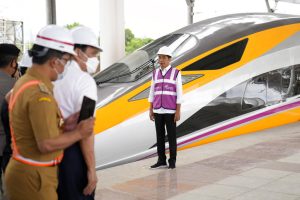Test runs are now underway for the long-awaited high-speed rail line linking Jakarta and Bandung, which means the project is nearing completion. But it hasn’t been an easy road. Construction of the 142-kilometer line, which was awarded to a consortium of Chinese companies in 2015, has gone over budget and been delayed by several years. According to Reuters, the entire undertaking will cost over $7 billion, including an additional $1.2 billion to cover cost overruns.
Even as the project nears completion, questions remain about its commercial viability and some of the planning choices. For instance, the train does not go all the way into the city center of either Bandung or Jakarta, a choice made by planners to avoid certain engineering and construction challenges but one that also entails some obvious trade-offs. Given that the project has incurred billions of dollars in loans from the China Development Bank, and that government officials now want to extend the line all the way to Surabaya, the question on everybody’s mind is: was it worth it?
The direct economic benefits are questionable. The line is only 142 kilometers long, and Bandung and Jakarta are not that far apart and are linked by many existing modes of transport including conventional rail and road. It’s definitely possible Indonesia’s first high-speed rail will never be profitable or recoup its $7 billion price tag. Personally, I am of the opinion that public works projects don’t need to turn a profit to be considered successful. Public transit systems, and especially high-speed rail lines, are often operated at a loss. There are other less tangible benefits that Indonesia might derive from this deal, and ultimately those are what will determine whether it was worth it or not.
It is true that Indonesia wanted this project so the country could have a high-speed rail line. But the real prize was to secure the transfer of technology, skills, and operational know-how so that one day Indonesian rail and construction companies can improve their position on the techno-industrial frontier. They are looking to acquire the production capabilities and knowledge to indigenously build and operate high-speed railways and rolling stock, or at least gain competency in some aspects of the process. The Chinese bid was ultimately chosen because those intangible benefits were reportedly offered as part of the package.
To that end, the project has been structured as a joint venture, called PT KCIC. A Chinese consortium holds a 40 percent stake in PT KCIC. The main Chinese investor is China Railway Engineering Corporation, a state-owned holding company and majority shareholder of China Railway Group Limited. China Railway Group Limited is an infrastructure construction giant that recorded revenue of $171 billion in 2022. They were also one of the main contractors for the recently built Laos-China high-speed rail.
An Indonesian consortium of state-owned companies, PT Pilar Sinergi BUMN, is the controlling partner in PT KCIC, with a 60 percent stake. When the project began, state-owned construction firm Wijaya Karya was the leader of the consortium with a 38 percent stake, followed by rail operator KAI, toll road operator Jasa Marga, and agricultural estate company PTPN VIII. The logic behind a state-owned construction company taking the lead was that they could absorb new techniques and know-how from China Railway Group during the construction process.
With the project going over budget, PT Pilar Sinergi BUMN was restructured last year. State-owned rail operator KAI has now taken over as the leading stakeholder, with 51 percent ownership. They also injected additional capital into the project. With the construction phase winding down, it makes sense for the national rail operator to take over from a construction firm. KAI is also one of Indonesia’s more well-run SOEs and therefore is in a better fiscal and operational position to handle a big project like this, whereas the state-owned construction sector has a less proven track record.
In the years ahead we will be able to look at KAI’s earnings from its stake in PT Pilar Sinergi BUMN and get a better idea of how the high-speed rail line is doing in a commercial sense. A much trickier question is whether critical skills and technologies were absorbed by Indonesian companies like Wijaya Karya during the construction process. This is a hard thing to measure, but in evaluating whether the Jakarta-Bandung high-speed rail line has been worth the time and money expended in its construction, it is the most important question.
































